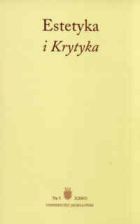Prawda dzieła sztuki w dobie jego technicznej reprodukcji
The Truth of the Work of Art in the Age of Mechanical Reproduction
An Attempt at a Heideggerian Interpretation of the Work of Art
Author(s): Robert RogozieckiSubject(s): Philosophy, Fine Arts / Performing Arts, Aesthetics
Published by: Wydawnictwo Uniwersytetu Jagiellońskiego
Summary/Abstract: The text attempts to find a way for Heidegger’s aesthetics, especially the concept of the truth of a work of art, to be applied to the analysis of the phenomenon of mass art. It takes as its point of departure Benjamin’s notion of mass art seen as art deprived of aura, i.e., art that is not situated in space and time. Merging Benjamin’s conceptual apparatus with Heidegger’s indicates that the notion of mass art needs major deepening. Above all, if we define high art in terms of existential truth and, in consequence, the way the work of art transcends the world in which it is rooted, then the non-auratic art will be defined by the notions of existential untruth, i.e., what will be pointed to is the way it is rooted in the world of Dasein. While the works of elite art always transcend this world, the works of mass art never do – they are worldly entities; they belong to the world (within-the-world entities). It means that the works of mass art have to be analysed primarily in terms of the ideological structures of the world in which they are rooted. This bears a number of ramifications for works of mass art, such as that they are not independent beings, but rather structural units, and also that their non-temporality is not just a result of the way they are produced and distributed, but also an effect of their origins in Dasein. Bearing in mind the structural character of the works of mass art, it seems necessary to outline a division into popular art, alternative art, and experimental art.
Journal: Estetyka i Krytyka
- Issue Year: 28/2013
- Issue No: 1
- Page Range: 133-164
- Page Count: 32
- Language: Polish

